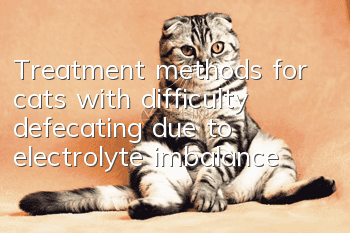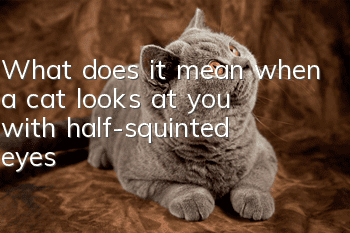Treatment methods for cats with difficulty defecating due to electrolyte imbalance

Cat’s endocrine disorders can also cause defecation difficulties. Endocrine disorders will change the cat’s internal environment, causing electrolyte disorders. The cat’s internal body fluids are composed of water and electrolytes, low-molecular organic compounds, and proteins dissolved in it. , widely distributed inside and outside tissue cells, forming the cat’s internal environment. Among them, most electrolytes exist in a free state. Various life activities of the body are inseparable from the participation of electrolytes, and even slight abnormalities may sometimes cause physiological dysfunction. Therefore, electrolytes play an extremely important role in maintaining the life activities of the body. In general, the physiological functions of electrolytes can be divided into the following three parts:
1. Maintain the osmotic balance and acid-base balance of body fluids;
2. Maintain the resting potential of nerves, muscles, and cardiomyocytes, and participate in the formation of their action potentials;
3. Participate in metabolic and physiological functional activities.
The main defecation difficulties in cats caused by electrolyte disorders are as follows:
1. Intestinal obstruction caused by hypokalemia
Cats rarely experience a decrease in potassium ion concentration when they eat a normal diet. However, when vomiting, diarrhea, or increased urine output occurs, potassium ions will be lost and can quickly develop hypokalemia. Clinical symptoms usually reflect excitatory tissues, including cardiac muscle, smooth muscle, and skeletal muscle. Changes in its concentration can cause significant abnormalities in the functions of these tissues, thereby worsening the body's condition. More attention must be paid in clinical diagnosis and treatment.
Hypokalemia can cause constipation in cats, mainly paralytic intestinal obstruction. Clinically, abdominal distension and bulging, loss of appetite, not eating or eating less, drinking only a small amount of water, vomiting and constipation can be seen. Initial vomitus contains undigested food and mucus. The vomitus subsequently contains bile and intestinal contents. Continued vomiting leads to dehydration of the body, causing electrolyte imbalance and accompanying alkalosis. Uremia develops in the late stage, and eventually collapse, shock and death.
If a cat is diagnosed with intestinal obstruction, surgical treatment should be performed immediately (and corresponding body fluids and electrolytes should be replenished) to remove the obstruction. If the blocked intestinal segment becomes necrotic, it should be resected and an intestinal anastomosis performed. On the day of fasting after surgery, liquid food will be given for the next 6-7 days. During the hunger strike, intravenous fluids should be given and antibiotics should be applied throughout the body.
It should be noted that hypokalemia can also cause a series of other diseases, such as the impact on the heart, including decreased myocardial contractility, decreased cardiac output and cardiac rhythm disorders. Clinical signs commonly include generalized skeletal muscle weakness. In cats, forward flexion of the neck, hyperextension of the forelimbs, and abduction of the hindlimbs can be seen. Cats are generally more susceptible to hypokalemia than dogs. Other metabolic disorders caused by hypokalemia include hypokalemic nephropathy (characterized by chronic tubulointerstitial nephritis, impaired renal function, and azotemia, polyuria, polydipsia, and concentrated urine).Impaired contractility), hypokalemic polymyopathy (increased serum creatine kinase and abnormal electromyography), etc. We should also adopt different treatments for different conditions.
2. Hypercalcemia
Hypercalcemia means that the calcium concentration in the blood exceeds the normal level. There are many causes of hypercalcemia, such as primary hyperparathyroidism, malignant tumors, vitamin D poisoning, kidney disease and Certain inflammatory diseases can occasionally cause hypercalcemia.
Difficulty defecation manifested by hypercalcemia is often associated with recurrence of other symptoms. No matter what the cause is, when the concentration of hypercalcemia reaches a certain level, it will affect nerves, muscles, digestion, cardiovascular, Functions of the urinary system, such as polydipsia, polyuria, decreased appetite, vomiting, constipation, lethargy, weakness and weight loss may occur. Because high circulating calcium concentrations are toxic to the kidneys, they may lead to renal failure. One-third of dogs with hyperparathyroidism develop kidney and bladder stones. Severe hypercalcemia can cause neurological symptoms such as muscle twitching, seizures, and coma, as well as changes in heart rate.
For the treatment of hypercalcemia constipation, the cause must first be determined and other symptoms should be taken into consideration for treatment. To minimize damage to the kidneys, it is important to lower blood calcium quickly. Intravenous administration of saline and diuretics (such as furosemide and thiazide diuretics) promotes urinary excretion of calcium. Once diagnosed, prednisone (a steroid drug) can help lower blood calcium. It should be avoided initially in suspected cases of cancer because it can make certain tumors (such as lymphoma, leukemia, or myeloma) more difficult to detect.
Once the underlying cause is identified, specific treatment should be instituted: the vast majority of parathyroid tumors require surgical removal. Lymphoma, multiple myeloma, and leukemia require chemotherapy. Other tumors may require surgery, chemotherapy, and/or radiation therapy. Calcium-lowering therapy and supportive therapy can be used in cases of vitamin D and vitamin D3 rodenticide poisoning.
- How to remove cat tear stains?
- Are British Shorthairs easy to raise? A must-read for novice cat owners!
- Why don't cats like water?
- What to prepare before neutering a male cat?
- What is the personality of Shandong Lion Cat?
- What is the difference between native cats and pet cats?
- How long does a Highland prick-eared cat live?
- Is Cymbidium poisonous to cats?
- The most common eye colors in cats
- What should I do if my kitten purrs while breathing?



